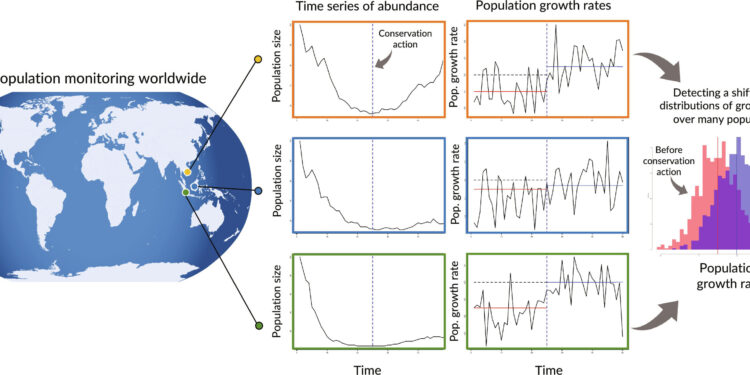Conceptual diagram of the trend assessment process. Monitoring produces time series of trends in abundance for many populations around the world; here we illustrate this for three populations. Our objectives are twofold: (i) assess trends and the risk of very rapid declines on a global scale and (ii) have the statistical power to detect whether population trends have generally improved following conservation measures ( vertical lines). To do this, we convert the population abundance time series (left column of the graphs) into estimates of the annual population growth rate (log(NOTt+1/NOTt)) (middle column of graphs) to account for expected temporal autocorrelation. We then estimate the average trend before (red horizontal lines) and after (blue horizontal lines) the implementation of conservation measures. We show three populations here, but in reality each country taxonomic group (system) is made up of many sampled populations. We pool the growth rates of all populations in a system, resulting in a distribution of growth rates (right) before (red) and after (blue) the action. We tested whether we could detect a change in the mean of the distribution, before and after conservation. Credit: Scientists progress (2024). DOI: 10.1126/sciadv.adj1448
More than ever, there is a growing interest in devoting resources to halt the loss of biodiversity, as recently illustrated by the Kunming-Montreal Global Biodiversity Framework (GBF) decided at COP15 in December 2022. The GBF focuses on understanding why biodiversity is declining. and what actions are needed to reverse this trend.
However, according to researchers at McGill University, implementing this plan is difficult because information on biodiversity changes is not equally available everywhere and is uncertain in many places.
With the data available, can the scientific community and policymakers really know whether they are making progress toward international biodiversity goals, even if their efforts have been effective? Research indicates that without a better idea of how and why biodiversity is changing in most countries, it is difficult to assess the effect of national plans presented in the GBF.
“Even if policies halted the decline of animal populations, we show mathematically that it will be difficult to detect improvements with high certainty in many places for different types of species (48 of 62 countries and species groups)” , explains Professor Brian Leung of McGill’s Department of Biology and Bieler School of Environment and lead author of the study.
“This is because detection of progress is limited by current levels of uncertainty in the data (records are either too sparse or too variable) describing trends in animal populations.”
To further explore this point, co-author Professor Andrew Gonzalez compares this problem to monitoring the recovery of heart health after illness.
“This would not be easy to do if a doctor had not kept good historical records of a person’s heart health, and without good past records it would be difficult to know whether the heart is recovering from the treatment that they are receiving. ‘it receives. Now imagine trying to detect whether heart health is improving on average among all Canadians (perhaps by following government dietary recommendations) whether heart health data at scale national data were not collected in the past or measured in the future.
Professor Gonzalez continues: “Instead of heart health, we assessed the health of animal populations (how quickly they are declining or recovering) and whether we can conclude whether populations are recovering worldwide. Tracking targets Biodiversity measures and assessing progress cannot be done properly without filling gaps in available information and reducing the uncertainty that hampers our ability to assess whether current trends are improving.
Measure efforts at all levels
In light of these findings, how should the scientific community and policymakers evaluate their efforts to achieve goals as ambitious as conserving 30% of land and water by 2030 and slowing the rate of extinction of species of human origin? The researchers make several suggestions, including proposing a risk framework that would establish unacceptable thresholds for biodiversity decline that are easier to detect.
Additionally, the authors suggest investing in national and international biodiversity monitoring systems to improve estimates of global trends.
As Professor Leung concludes: “Our results highlight the need to be careful to structure how we gather knowledge about biodiversity, so that we can report on whether we have succeeded in meeting our global targets through international investment in conservation. of nature or, alternatively, whether we need to reorient our actions.
In summary, these recommendations propose a more rigorous approach to interpreting biodiversity trends, incorporating risk considerations, boosting investments in monitoring, explicitly deciding thresholds for success, and using benchmarks to make informed decisions about biodiversity. conservation. If implemented, many countries could benefit, given the international reach of the GBF.
“Global Biodiversity Monitoring: Uncertainty, Risk, and Power Analyzes to Support Detection of Trend Changes” by Brian Leung and Andrew Gonzalez is published in Scientists progress.
More information:
Brian Leung et al, Global Biodiversity Monitoring: Uncertainty, Risk and Power Analyzes to Support Detection of Trend Changes, Scientists progress (2024). DOI: 10.1126/sciadv.adj1448
Provided by McGill University
Quote: Measurement uncertainty could block global biodiversity targets (February 19, 2024) retrieved February 19, 2024 from
This document is subject to copyright. Apart from fair use for private study or research purposes, no part may be reproduced without written permission. The content is provided for information only.



